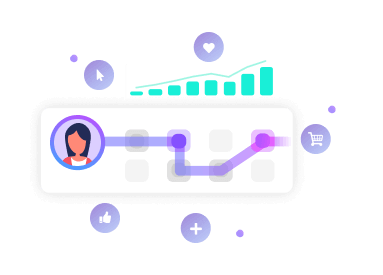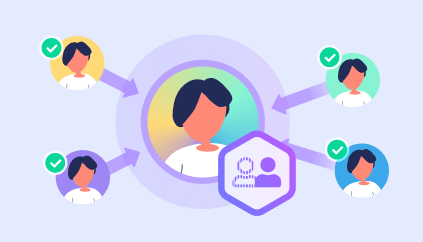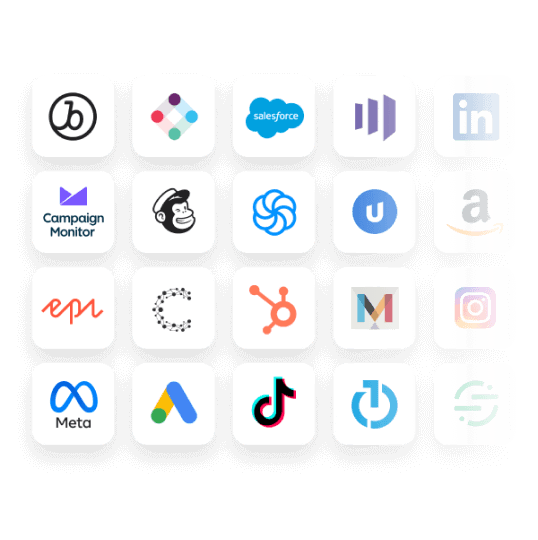People-based marketing: What it is and how it works
January 17, 2023

You probably use cookies to track website visitors. This is handy because you can see which products a certain user is interested in and can market these products to them. The only problem is that the average US household uses seven screens to view content. Since cookies track devices and not users, they can’t keep up.This is where people-based marketing can help. It lets you connect your customer data to their online identities, so you’re targeting real people, not devices. This optimizes personalized marketing because you have a 360-degree view of customer profiles.
If you’ve got questions about people-based marketing, we’ve got answers.
What is people-based marketing?
People-based marketing focuses on targeting real people instead of audience segments or devices. This gives you full control over your marketing because you can tailor messages to a specific person’s interest.
For example, let’s say Jane visits your online store on her mobile phone and keeps going to this one page. Maybe it’s the product description page for a new coffee machine. Your cookies will track this and you can personalize marketing around this coffee machine. But later in the day, she uses her desktop to do more research. Your cookies will view this as a new person, limiting your marketing abilities.

But when you utilize people-based marketing, you store customer data in a CDP (customer data platform) and gain a complete view of their behaviors across devices. So when customers use a different device to visit your website, you’ll notice it, allowing you to personalize ads.
Why is people-based measurement important?
Thinking about introducing people-based marketing into your workflow to build better retargeting campaigns? Great! Here are three benefits you can expect to experience:
- Manage customer relationships
- Take the guesswork out of audience targeting
- Match customer devices to their profile
1. Manage customer relationships
The best part about people-based marketing is that it lets you build one-on-one customer relationships. Instead of using vague words like “audience” and “buyer persona,” you know almost everything about a specific customer such as their name, email address, buying preferences, and demographic data.

So when this customer visits your website, you can personalize their experience with your brand.
2. Take the guesswork out of audience targeting
People-based marketing also removes the guesswork from audience targeting.
For example, you aren’t building buyer personas based on who you think will need your product; you target people based on data you’ve collected. This makes people-based marketing ideal during marketing budget cuts. You aren’t funding ineffective campaigns that rely on guesswork. Your entire budget is going toward marketing ideas that work.
3. Match customer devices to their profile
In a perfect world, you should be able to use cookies to track a device’s behaviors and tailor marketing to these behaviors. However, customers are using several screens to engage with your content.

Maybe they’ll watch your videos on their computer when they’re at work, and when they get home, they’ll read your articles on their phone. So you can’t assume each device is a new user. Fortunately, when you use a CDP to organize customer data, you can store several devices under one customer profile. This gives you control over marketing since customers won’t have to see the same ad multiple times.
How to build a successful person-based marketing strategy
Here’s how you can build a successful person-based marketing strategy in two simple steps:
- Collect and organize customer data
- Integrate your CDP with your marketing tools
1. Collect and organize customer data
The first step is collecting and organizing customer data because it’s the foundation for your person-based marketing strategy. Use a CDP like Lytics to gather customer data from surveys, transactional records, and social media analytics and organize it so it’s easy to understand. With Lytics, you can build a 360-degree view of customers within a few minutes of importing data, so you won’t have to manually manage anything.
2. Integrate your CDP with your marketing tools
Now that you have a complete profile of customers, use this information to push them in the right direction, regardless of what device they are using.

This is super easy with Lytics since it integrates with marketing tools like:
- Amazon Advertising
- AdRoll
- Big Commerce
- Campaign Monitor
- Google Ads
By connecting Lytics to these marketing automation tools, you can automate customer experiences without doing much of the heavy lifting. For instance, if you see that a customer is interested in buying a particular product from you, connect Lytics to your Google Ads account and run pay-per-click ads based on their profile.
People-based marketing made easy with Lytics
People-based marketing focuses on the individual customer and not devices or audience segments. So it doesn’t matter if a customer interacts with your brand using their laptop and mobile phone—you’ll be able to recognize that it’s the same person and can adjust marketing accordingly.
If you’re looking to utilize people-based marketing, the first thing you’ll have to do is organize data under one digital roof, which is where Lytics comes in. Our CDP gives you a detailed understanding of customer behaviors while integrating with your marketing tools, without compromises or disruption.



